PLUMBERS AND GASFITTERS UNION BUILDING
50-52 VICTORIA STREET CARLTON, MELBOURNE CITY
-
Add to tour
You must log in to do that.
-
Share
-
Shortlist place
You must log in to do that.
- Download report




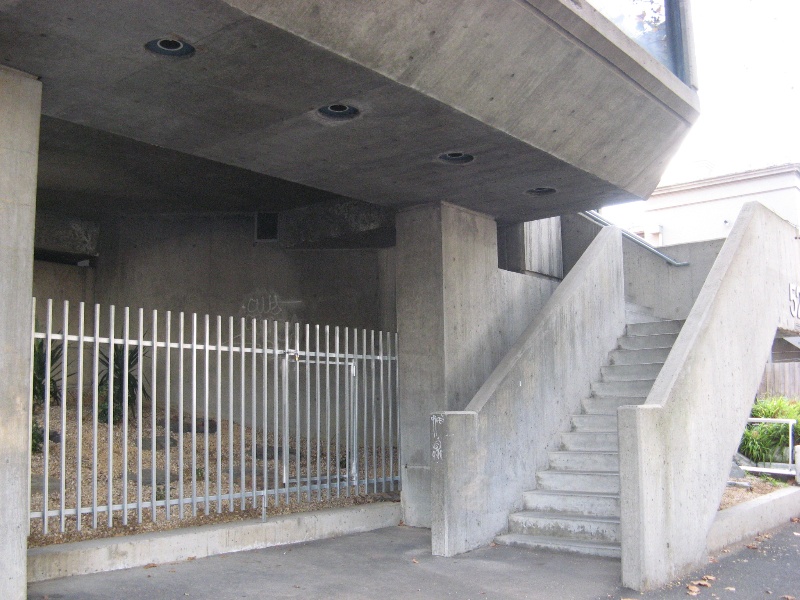

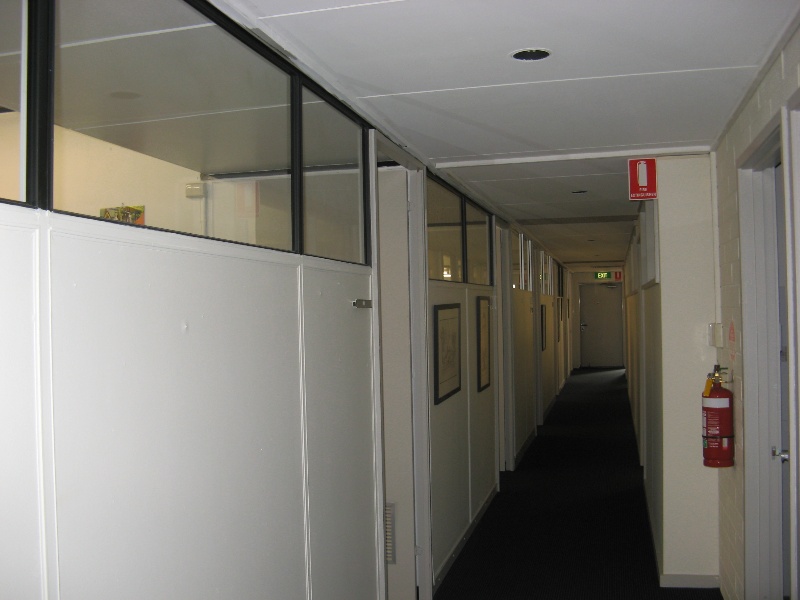

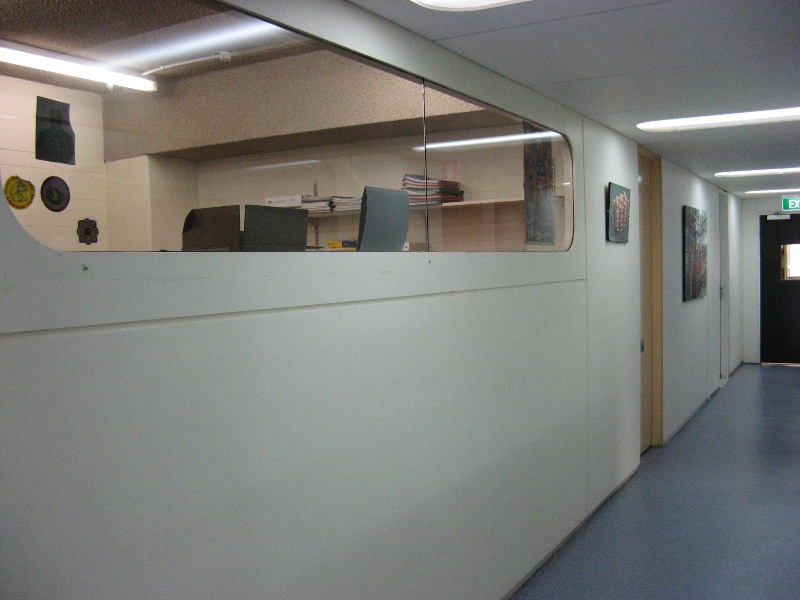
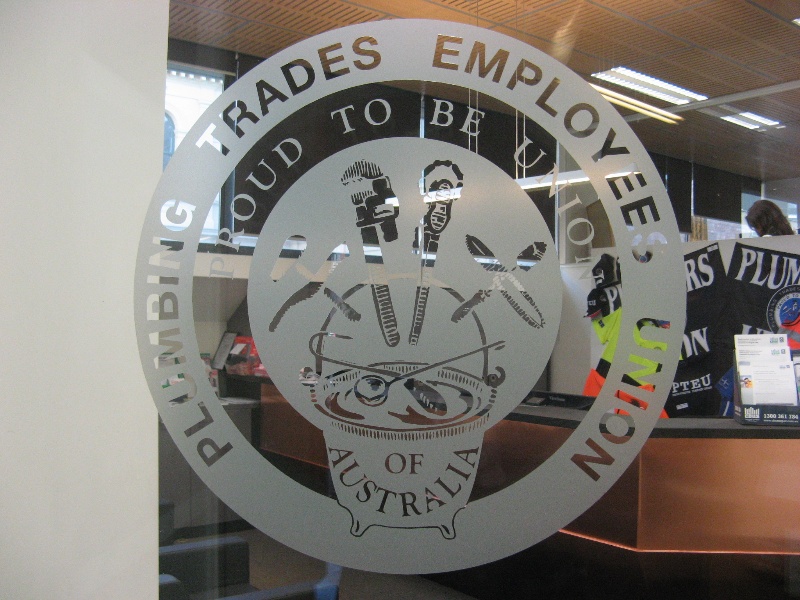
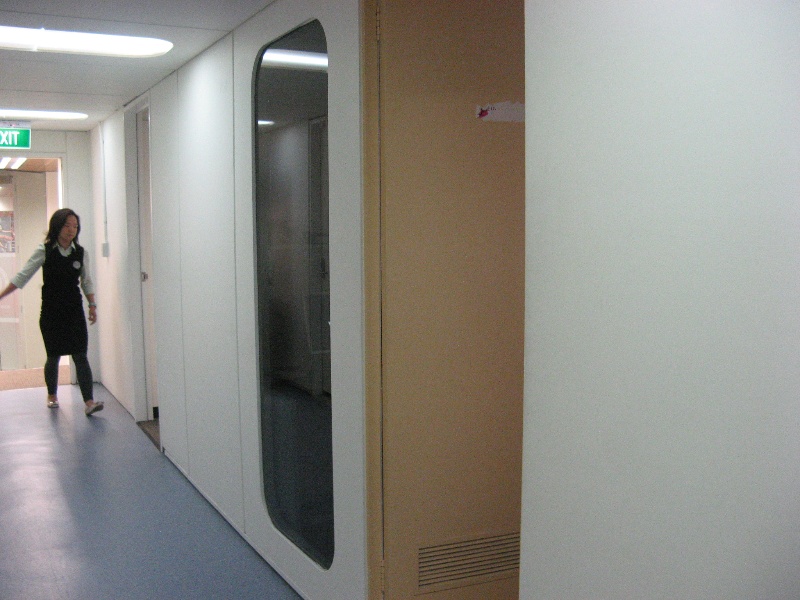

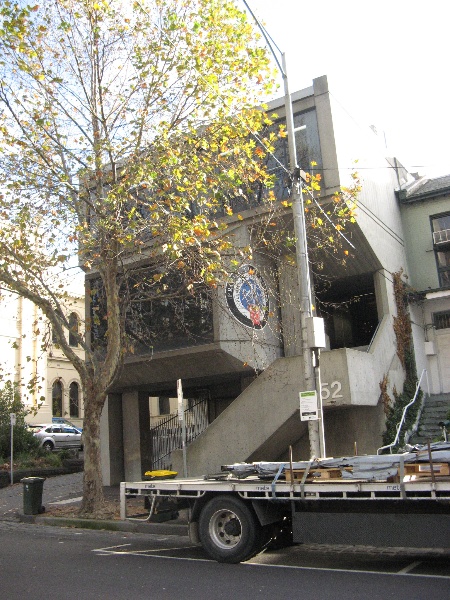
Statement of Significance
What is significant?
The Plumbers and Gasfitters Union Building is a highly distinctive building designed by Graeme Gunn and built in 1969-71 in Victoria Street, Carlton. It is one of the earliest and finest examples of the Brutalist style in Victoria.
The Plumbers and Gasfitters Employees' Union was formed in 1911 and was originally housed in the Trades Hall complex on the corner of Victoria and Lygon Streets, Carlton. By the late 1960s the union had outgrown these premises and the architect Graeme Gunn was commissioned to design a new building on a site adjacent to the Trades Hall.
The design of the office building was intended to establish an identity for the union, meet their increased space requirements and provide for possible future expansion. Gunn designed a three storey building with car parking and mechanical services at ground level, office space for the client on the first floor and lettable space on the floor above. The structure, designed to enable the addition of two extra floors, is of reinforced concrete with an off-form finish on all external and major internal surfaces. Windows are aluminium framed with dark smoked glazing and are deeply recessed on the west facade to provide some sun control.
Adopting a tough Brutalist exterior, the building is a bold statement of growing trade union power. The design emphasises both stucture and material with an unorthodox and purposeful arrangements of masses and voids. The vertical imprint of the patterned tempered formwork lining, and the regular set of filled holes which indicate the rod supports for the formwork, show an honest use of construction materials and exposure of natural finishes. The clear indication of circulation patterns, as evident in the dominant front staircase, is an important Brutalist characteristic.
The Plumbers and Gasfitters Union Building received a Victorian Architectural Award Citation in 1971 and the 25 Year RAIA Victorian Architecture Award for Enduring Architecture in 2007, and the design influenced architecture in Victoria throughout the 1970s.
This site is part of the traditional land of the Kulin Nation.
How is it significant?
The Plumbers and Gasfitters Union Building is of architectural and historical significance to the state of Victoria.
Why is it significant?
The Plumbers and Gasfitters Union Building is of architectural significance as one of the earliest, finest and most influential examples of the Brutalist style in Victoria. It is notable for its use of bold forms constructed in off-form concrete and its tough exterior provides the client with an identity signifying union power. It is recognised as a major work of the Melbourne architect Graeme Gunn, who has remained highly influential in the architectural profession. He was recognised with the RAIA Victorian Chapter President's Award for Lifetime Contribution to Victorian Architecture in 2001 and the Australian Institute of Architects highest award, the Gold Medal for Architecture in 2011.
The Plumbers and Gasfitters Union Building is of historical significanceas a substantial physical reminder of the strength and influence of the union movement in the 1970s.
-
-
PLUMBERS AND GASFITTERS UNION BUILDING - History
The Plumbers and Gasfitters Employees' Union was formed in 1911 and was originally housed in the Trades Hall complex on the corner of Victoria and Lygon Streets, Carlton. By the late 1960s the union had outgrown these premises and architect Graeme Gunn Pty Ltd was commissioned to design the new building on a site adjacent to the Trades Hall in 1969. This was described as being in creative collaboration with landscape designed Ellis Stones and Merchant Builders, and construction was completed in 1971. It cost $17,000. The builder was T R & L Cochram and engineer S Ramschin & Associates.
The brief called for an office building which would establish an identity for the union, meet their increased space requirements and provide for future expansion. Gunn's response was a bold statement of growing trade union power and it became a local Brutalist landmark.
The Plumbers and Gasfitters Union Building received a Victorian Architectural Award Citation in 1971 and was selected as one of 36 best buildings by the architectural profession in Judging Architecture in 2003. The architect Graeme Gunn received the President's Award for Lifetime Contribution to Victorian Architecture in 2001, the 25 Year RAIA Victorian Architecture Award for Enduring Architecture for the Plumbers and Gasfitters Union Building in 2007 and the Gold Medal for Architecture in 2011.
Miles Lewis suggests that the Plumbers and Gasfitters Union Building is the 'stand out' example of Brutalism, which he says was 'linked with left-wing architectural programmes' that sought to improve the lives of the masses.
Brutalism
A critique of the uniformity of pre-war Modernism was New Brutalism, a term coined in 1952 by London architects Peter and Alison Smithson. It built on the work of modern architecture pioneer Le Corbusier. Expressed structure and materials, especially brick and off-form concrete and graphically functional external expression were the "honest' design recipe. Inspiration varied and included outright emulation of the off-form concrete postwar architecture of Le Corbusier. In Melbourne, the Harold Holt Pool and Plumbers and Gasfitters' Union Building are two of the best examples.
Characteristics included:
Unorthodox arrangement of masses and voids Honest valuation of construction materials and exposure of natural finishes Transparency of programme thorugh the plan Emphasis on circulationThe Brutalist movement emerged in Victoria in the late 1960s with both aesthetic and ethical imperatives. The latter was a social concern which placed the user at the centre of the design and expressed construction materials as finised surfaces. Circulation elements were clearly evident and functional systems articulated.
In the 1960s, houses in Melbourne indicated a shift towards New Brutalism and the Total Carpark, 170-190 Russell Street, 1964-65 Bogle, Banfield and Associates, heralded the arrival of the style in Victoria. There were Japanese influences in many Brutalist designs, including the use of off form concrete, emphatic structural and functional expression.
Menzies College, La Trobe University (Bundoora Romberg and Boyd 1965-70) is designed in the Brutalist idiom with a robust use of off-form concrete, pod projections and bold angled struts. The Harold Holt Pool, Glen Iris (Kevin Borland and Daryl Jackson 1967-69) uses concrete block and off-form concrete construction, industrially glazed walls and timber trusses, circulation elements which become sculptural features, chamfered walls and skillion roofs.
Graeme Gunn
Gunn studied architecture at the Royal Melbourne Institute of Technology between 1955 and 1960 and became a registered architect in 1963. From 1961 to 1963 he was employed in the office of Grounds, Romberg and Boyd and in 1964 he commenced architectural pracice in his own right. From 1971 to 1982 the firm operated as Gunn Hayball Architects and from 1982 to 1986 as Gunn Williams Fender. From 1986 to 2009 the practice was Graeme Gunn Architects and from 2009 has been Gunn Dyring Aerchitects.
Gunn made an important contribution to architectural education, first as Head of the School of Architecture and Building at RMIT (1972-77) then as Foundation Dean of the Faculty of Archtiecture and Builiding at RMIT (1977-1982).
He has received a number of architectural awards for his designs and pracitice. These include the President's Award for Lifetime Contribution to Victorian Architecture in 2001, the 25 Year RAIA Victorian Architecture Award for Enduring Architecture for the Plumbers and Gasfitters Union Building in 2007 and the Gold Medal for Architecture in 2011. The jury citation for the latter describes the Plumbers and Gasfitters Union building as 'spectacular' and testimonials describe it as one of the State's iconic buildings.
He was awarded an Honorary Doctorate of Architecture from RMIT University in 1966 and is a Life Fellow of the RAIA.
REFERENCES
Architect, vol 3, no 14 July-August 1971, p 22, 'New Union Building'
Architecture in Australia, vol 61, no 4, August 1972, 'Office, Plumbers and Gasfitters Employees Union'
P Goad, Melbourne Architecture, p 203
J Taylor Australian Architecture since 1960, p 85
'Our modern heritage is set in concrete' in The Age, 24 December 2005
Gunndyring Website http://www.gunndyring.com.au
National Trust Register
Australian Institute of Architects Website http://www.architecture.com.au
PLUMBERS AND GASFITTERS UNION BUILDING - Assessment Against Criteria
a Importance to the course, or pattern, of Victoria's cultural history
The Plumbers and Gasfitters Union Building provides a substantial physical reminder of the strength and influence of the union movement in the 1970s.
b. Possession of uncommon, rare or endangered aspects of Victoria's cultural history.
c. Potential to yield information that will contribute to an understanding of Victoria's cultural history.
d. Importance in demonstrating the principal characteristics of a class of cultural places or environments.
The Plumbers and Gasfitters Union Building is one of the earliest, finest and most influential examples of Brutalist architecture in Victoria. It is notable for its use of bold forms constructed in off-form concrete and for its tough exterior which provides the client with an identity signifying union power. In 2007 the building was awarded the 25 Year RAIA Victorian Architecture Award for Enduring Architecture.
.
e. Importance in exhibiting particular aesthetic characteristics.
f. Importance in demonstrating a high degree of creative or technical achievement at a particular period.
g. Strong or special association with a particular community or cultural group for social, cultural or spiritual reasons. This includes the significance of a place to Indigenous peoples as part of their continuing and developing cultural traditions.
h. Special association with the life or works of a person, or group of persons, of importance in Victoria's history.
The Plumbers and Gasfitters Union Building is recognised as a major work of the Melbourne architect Graeme Gunn, who has remained highly influential in the architectural profession. His outstanding contribution to architecture in Victoria was recognised with the RAIA Victorian Chapter President's Award for Lifetime Contribution to Victorian Architecture in 2001 and the Australian Institute of Architects highest award, the Gold Medal for Architecture in 2011.
PLUMBERS AND GASFITTERS UNION BUILDING - Plaque Citation
Designed by architect Graeme Gunn, this highly distinctive and influential building was constructed in 1969-71. As an early and outstanding example of the Brutalist style, it provided the union with a powerful identity.
PLUMBERS AND GASFITTERS UNION BUILDING - Permit Exemptions
General Exemptions:General exemptions apply to all places and objects included in the Victorian Heritage Register (VHR). General exemptions have been designed to allow everyday activities, maintenance and changes to your property, which don’t harm its cultural heritage significance, to proceed without the need to obtain approvals under the Heritage Act 2017.Places of worship: In some circumstances, you can alter a place of worship to accommodate religious practices without a permit, but you must notify the Executive Director of Heritage Victoria before you start the works or activities at least 20 business days before the works or activities are to commence.Subdivision/consolidation: Permit exemptions exist for some subdivisions and consolidations. If the subdivision or consolidation is in accordance with a planning permit granted under Part 4 of the Planning and Environment Act 1987 and the application for the planning permit was referred to the Executive Director of Heritage Victoria as a determining referral authority, a permit is not required.Specific exemptions may also apply to your registered place or object. If applicable, these are listed below. Specific exemptions are tailored to the conservation and management needs of an individual registered place or object and set out works and activities that are exempt from the requirements of a permit. Specific exemptions prevail if they conflict with general exemptions. Find out more about heritage permit exemptions here.Specific Exemptions:General Conditions: 1. All exempted alterations are to be planned and carried out in a manner which prevents damage to the fabric of the registered place or object. General Conditions: 2. Should it become apparent during further inspection or the carrying out of works that original or previously hidden or inaccessible details of the place or object are revealed which relate to the significance of the place or object, then the exemption covering such works shall cease and Heritage Victoria shall be notified as soon as possible. General Conditions: 3. If there is a conservation policy and plan all works shall be in accordance with it. Note:A Conservation Management Plan or a Heritage Action Plan provides guidance for the management of the heritage values associated with the site. It may not be necessary to obtain a heritage permit for certain works specified in the management plan. General Conditions: 4. Nothing in this determination prevents the Executive Director from amending or rescinding all or any of the permit exemptions. General Conditions: 5. Nothing in this determination exempts owners or their agents from the responsibility to seek relevant planning or building permits from the responsible authorities where applicable. Minor Works : Note: Any Minor Works that in the opinion of the Executive Director will not adversely affect the heritage significance of the place may be exempt from the permit requirements of the Heritage Act. A person proposing to undertake minor works must submit a proposal to the Executive Director. If the Executive Director is satisfied that the proposed works will not adversely affect the heritage values of the site, the applicant may be exempted from the requirement to obtain a heritage permit. If an applicant is uncertain whether a heritage permit is required, it is recommended that the permits co-ordinator be contacted.PLUMBERS AND GASFITTERS UNION BUILDING - Permit Exemption Policy
The purpose of the Permit Policy is to assist when considering or making decisions regarding works to the place. It is recommended that any proposed works be discussed with an officer of Heritage Victoria prior to making a permit application. Discussing any proposed works will assist in answering any questions the owner may have and aid any decisions regarding works to the place. It is recommended that a Conservation Management Plan is undertaken to assist with the future management of the cultural significance of the place.
The cultural heritage significance of the place is principally due to its architectural significance as an early, innovative and highly intact example of Brutalist design and as a major example of the work of Melbourne architect Graeme Gunn. The extent of registration protects the whole site. All of the registered building is integral to the significance of the place and any external or internal alterations are subject to permit application. The addition of new buildings to the site may impact upon the cultural heritage significance of the place and requires a permit. The purpose of this requirement is not to prevent any further development on this site, but to enable control of possible adverse impacts on heritage significance during that process.
-
-
-
-
-
BRASSEY HOUSE
 Victorian Heritage Register H0026
Victorian Heritage Register H0026 -
FORMER KENSINGTON PROPERTY EXCHANGE, OFFICE, SHOP AND RESIDENCES
 Victorian Heritage Register H1204
Victorian Heritage Register H1204 -
FORMER BURGE BROS FACTORY
 Victorian Heritage Register H1216
Victorian Heritage Register H1216
-
"1890"
 Yarra City
Yarra City -
"AMF Officers" Shed
 Moorabool Shire
Moorabool Shire -
"AQUA PROFONDA" SIGN, FITZROY POOL
 Victorian Heritage Register H1687
Victorian Heritage Register H1687
-
Abruzzo Club
 Merri-bek City
Merri-bek City -
Albanian Mosque
 Yarra City
Yarra City -
BAKER HOUSE
 Victorian Heritage Register H2118
Victorian Heritage Register H2118
-
-















